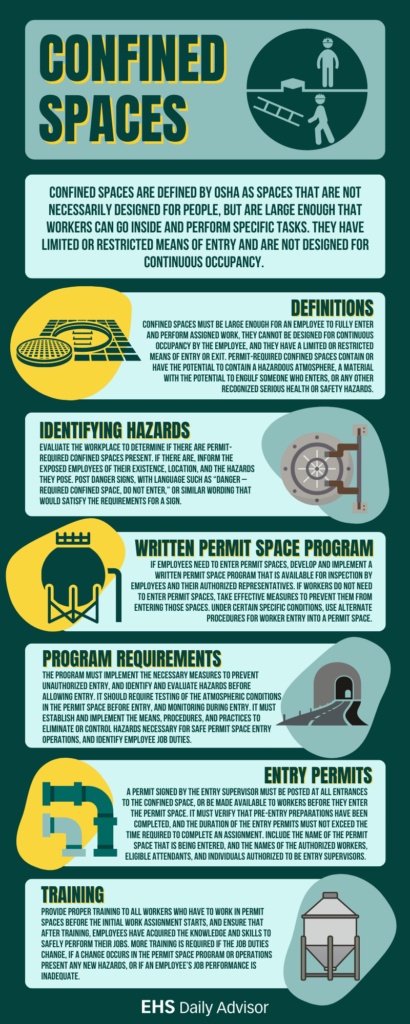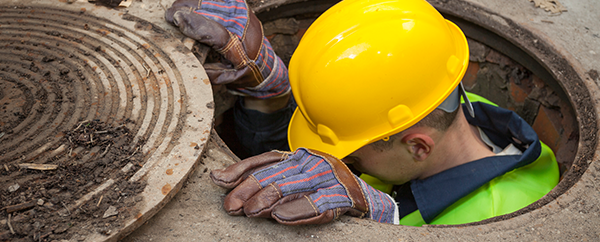Employ these confined space safety tips for your workers [infographic]
- A confined space isn’t just small. It has limited openings and poor natural ventilation, such as vats, silos or pipelines.
- Learn when a confined space must be permitted – and when it’s not necessary.
- View types of safety signage that should be posted on your confined space.
- Learn more ways to keep your workers safe, from equipment needs and limiting access, to pre-entry procedures.
Working in confined spaces such as ductwork, equipment housings, pipelines or storage bins requires safety practices to protect your employees. These are restrictive spaces large enough to hold a worker, allowing him or her to do the job temporarily, but has a limited entry or exit. It’s crucial to protect your employees by integrating these confined space safety tips for your workers.
What exactly is a “confined space”?
It’s a “space which, by design, has limited openings for entry and exit, unfavorable natural ventilation which could contain or produce dangerous air contaminants, and which is not intended for continuous worker occupancy,” says the National Institute for Occupational Safety and Health (NIOSH). These encompass a wide range of restrictive areas, such as
- Storage tanks, hoppers or silos
- Process vessels and reaction vessels
- Pits
- Vats, boilers or degreasers
- Ventilation and exhaust ducts
- Pipelines, sewers and tunnels
- Underground utility vaults
Related: How to uphold OSHA’s standards with 4 pillars of health and safety compliance
Why can working in a confined space be hazardous?
Often, poor air quality is the main cause for danger. There can be insufficient oxygen present, or it may be infiltrated by a poisonous gas, dust or grain that can impair judgment, make the worker ill or lose consciousness. Other dangers include excessive heat, a flammable atmosphere and flowing liquids or solids that could potentially engulf your worker. OSHA requires many of these spaces to be permitted prior to a worker’s entry, so we’re passing along this list of confined space safety tips.
What’s the difference between confined spaces requiring or not requiring a permit?
NIOSH defines confined spaces as those that are
- Large enough for an employee to enter and perform work
- Have limited or restricted means for entry or exit, and
- Are not designed for continuous occupancy
Spaces that meet these definitions without introducing any additional hazards are non-permitted. OSHA requires a sign such as the one below be posted outside the entrance.

Example of non-permit required sign, courtesy of SafetySign.com
A permit-required confined space (“permit space”), in addition to having the three characteristics listed above, also may have one or more of these potentially dangerous conditions present:
- May contain a hazardous atmosphere
- Includes materials that could engulf the worker
- Has an internal configuration such that a worker could be trapped or asphyxiated by inwardly converging walls or by a floor that slopes downward and tapers to a smaller cross-section
- Contains any other recognized safety threat, such as unguarded machinery, heat stress or exposed live wires

Example of permit-required sign, courtesy of SafetySign.com
Related: Workplace safety reward programs help stop accidents before they start
How can we protect our workers entering these confined spaces?
OSHA’s compliance requirements are a basis for developing effective confined space programs. Examine the standard carefully for specific information that will save lives. The following is a general overview of confined space safety tips.
Confined space programs must include:
- Measures necessary to prevent unauthorized entry. If employers determine the workplace contains permit spaces, they should inform workers of the existence, location and danger. Restrict employees not allowed to enter permit-required spaces and take effective measures to prevent entry.
- Means to identify and evaluate hazards associated with confined spaces. Before anyone enters the permit space, take precautions to prevent the entrance of inert gases, flammable or hazardous materials by blanking or valving off, in conjunction with a lockout system. Test the air within the space for oxygen deficiency, flammable gases or vapors and toxic materials. If you identify a hazardous condition, take steps to eliminate or alleviate the condition, such as purging the space with steam, water, air or an inert gas. However, note that the use of steam or inert gas will cause oxygen deficiency, so follow up with good air ventilation. Lock out and tag all energy sources — electrical, pneumatic, hydraulic, steam and gravity. In addition, block moving equipment.
- Procedures and practices necessary for safe entry and operations. Employers must provide training to all workers who might be involved with confined-space entry operations before they are first assigned duties associated with confined spaces. Documentation for the training includes workers who are certified and the dates of training.
- Appropriate equipment to accomplish the job safely. Personal protective equipment such as coveralls, chemical protective clothing, safety eyewear, hearing protection, hard hat, gloves, boots, respiratory equipment and leathers, if welding, might be necessary. Those entering the space should use a full-body harness with a lifeline attached and have a communication system in place.
- Pre-entry evaluation procedures and continued monitoring procedures during entry for oxygen, flammable gases or vapors and toxic gases or vapors.
- Attendant(s) stationed outside the confined space with specific responsibilities. Station a trained attendant immediately outside the space. Ventilation fans, or blowers and hoses may be necessary to keep the atmosphere inside the space within safe limits. You should conduct confined-space atmospheric testing and record the results. To perform the needed tasks, non-sparking, pneumatic and/or low voltage electrical equipment may be necessary.
- Specified authorized entrants, attendants, entry supervisors or persons who test and monitor entry conditions. Identify the responsibilities for each function and ensure adequate training.
- Procedures for summoning rescue and emergency personnel. Ensure that the rescue service used will be timely and available during the permit space entry.
- Procedures for concluding or securing entry operations.
- Program review and evaluation procedures, both following entry operations and as an annual process.
Because your workers are, in essence, putting their lives on the line to perform these duties, it’s crucial that you follow these confined space safety guidelines to protect your employees. View the infographic below, courtesy of EHS Daily Advisor.

Agents, take a look at our Workers’ Compensation Program to add to your portfolio of insurance solutions.
You can find more help at:
https://www.osha.gov/SLTC/confinedspaces/hazards_solutions.html
https://www.osha.gov/confinedspaces/index.html
This article originally ran in our Tribal blogpost. It has been modified and updated to better fit the needs of Arrowhead’s producers and their commercial clients.

